Xiaoyan Gu
Value-Aligned Prompt Moderation via Zero-Shot Agentic Rewriting for Safe Image Generation
Nov 12, 2025Abstract:Generative vision-language models like Stable Diffusion demonstrate remarkable capabilities in creative media synthesis, but they also pose substantial risks of producing unsafe, offensive, or culturally inappropriate content when prompted adversarially. Current defenses struggle to align outputs with human values without sacrificing generation quality or incurring high costs. To address these challenges, we introduce VALOR (Value-Aligned LLM-Overseen Rewriter), a modular, zero-shot agentic framework for safer and more helpful text-to-image generation. VALOR integrates layered prompt analysis with human-aligned value reasoning: a multi-level NSFW detector filters lexical and semantic risks; a cultural value alignment module identifies violations of social norms, legality, and representational ethics; and an intention disambiguator detects subtle or indirect unsafe implications. When unsafe content is detected, prompts are selectively rewritten by a large language model under dynamic, role-specific instructions designed to preserve user intent while enforcing alignment. If the generated image still fails a safety check, VALOR optionally performs a stylistic regeneration to steer the output toward a safer visual domain without altering core semantics. Experiments across adversarial, ambiguous, and value-sensitive prompts show that VALOR significantly reduces unsafe outputs by up to 100.00% while preserving prompt usefulness and creativity. These results highlight VALOR as a scalable and effective approach for deploying safe, aligned, and helpful image generation systems in open-world settings.
AILoRA: Function-Aware Asymmetric Initialization for Low-Rank Adaptation of Large Language Models
Oct 09, 2025Abstract:Parameter-efficient finetuning (PEFT) aims to mitigate the substantial computational and memory overhead involved in adapting large-scale pretrained models to diverse downstream tasks. Among numerous PEFT strategies, Low-Rank Adaptation (LoRA) has emerged as one of the most widely adopted approaches due to its robust empirical performance and low implementation complexity. In practical deployment, LoRA is typically applied to the $W^Q$ and $W^V$ projection matrices of self-attention modules, enabling an effective trade-off between model performance and parameter efficiency. While LoRA has achieved considerable empirical success, it still encounters challenges such as suboptimal performance and slow convergence. To address these limitations, we introduce \textbf{AILoRA}, a novel parameter-efficient method that incorporates function-aware asymmetric low-rank priors. Our empirical analysis reveals that the projection matrices $W^Q$ and $W^V$ in the self-attention mechanism exhibit distinct parameter characteristics, stemming from their functional differences. Specifically, $W^Q$ captures task-specific semantic space knowledge essential for attention distributions computation, making its parameters highly sensitive to downstream task variations. In contrast, $W^V$ encodes token-level feature representations that tend to remain stable across tasks and layers. Leveraging these insights, AILoRA performs a function-aware initialization by injecting the principal components of $W^Q$ to retain task-adaptive capacity, and the minor components of $W^V$ to preserve generalizable feature representations. This asymmetric initialization strategy enables LoRA modules to better capture the specialized roles of attention parameters, thereby enhancing both finetuning performance and convergence efficiency.
Towards Confidential and Efficient LLM Inference with Dual Privacy Protection
Sep 11, 2025Abstract:CPU-based trusted execution environments (TEEs) and differential privacy (DP) have gained wide applications for private inference. Due to high inference latency in TEEs, researchers use partition-based approaches that offload linear model components to GPUs. However, dense nonlinear layers of large language models (LLMs) result in significant communication overhead between TEEs and GPUs. DP-based approaches apply random noise to protect data privacy, but this compromises LLM performance and semantic understanding. To overcome the above drawbacks, this paper proposes CMIF, a Confidential and efficient Model Inference Framework. CMIF confidentially deploys the embedding layer in the client-side TEE and subsequent layers on GPU servers. Meanwhile, it optimizes the Report-Noisy-Max mechanism to protect sensitive inputs with a slight decrease in model performance. Extensive experiments on Llama-series models demonstrate that CMIF reduces additional inference overhead in TEEs while preserving user data privacy.
T2R-bench: A Benchmark for Generating Article-Level Reports from Real World Industrial Tables
Aug 27, 2025Abstract:Extensive research has been conducted to explore the capabilities of large language models (LLMs) in table reasoning. However, the essential task of transforming tables information into reports remains a significant challenge for industrial applications. This task is plagued by two critical issues: 1) the complexity and diversity of tables lead to suboptimal reasoning outcomes; and 2) existing table benchmarks lack the capacity to adequately assess the practical application of this task. To fill this gap, we propose the table-to-report task and construct a bilingual benchmark named T2R-bench, where the key information flow from the tables to the reports for this task. The benchmark comprises 457 industrial tables, all derived from real-world scenarios and encompassing 19 industry domains as well as 4 types of industrial tables. Furthermore, we propose an evaluation criteria to fairly measure the quality of report generation. The experiments on 25 widely-used LLMs reveal that even state-of-the-art models like Deepseek-R1 only achieves performance with 62.71 overall score, indicating that LLMs still have room for improvement on T2R-bench. Source code and data will be available after acceptance.
Capture Global Feature Statistics for One-Shot Federated Learning
Mar 10, 2025Abstract:Traditional Federated Learning (FL) necessitates numerous rounds of communication between the server and clients, posing significant challenges including high communication costs, connection drop risks and susceptibility to privacy attacks. One-shot FL has become a compelling learning paradigm to overcome above drawbacks by enabling the training of a global server model via a single communication round. However, existing one-shot FL methods suffer from expensive computation cost on the server or clients and cannot deal with non-IID (Independent and Identically Distributed) data stably and effectively. To address these challenges, this paper proposes FedCGS, a novel Federated learning algorithm that Capture Global feature Statistics leveraging pre-trained models. With global feature statistics, we achieve training-free and heterogeneity-resistant one-shot FL. Furthermore, we extend its application to personalization scenario, where clients only need execute one extra communication round with server to download global statistics. Extensive experimental results demonstrate the effectiveness of our methods across diverse data heterogeneity settings. Code is available at https://github.com/Yuqin-G/FedCGS.
Know2Vec: A Black-Box Proxy for Neural Network Retrieval
Dec 20, 2024



Abstract:For general users, training a neural network from scratch is usually challenging and labor-intensive. Fortunately, neural network zoos enable them to find a well-performing model for directly use or fine-tuning it in their local environments. Although current model retrieval solutions attempt to convert neural network models into vectors to avoid complex multiple inference processes required for model selection, it is still difficult to choose a suitable model due to inaccurate vectorization and biased correlation alignment between the query dataset and models. From the perspective of knowledge consistency, i.e., whether the knowledge possessed by the model can meet the needs of query tasks, we propose a model retrieval scheme, named Know2Vec, that acts as a black-box retrieval proxy for model zoo. Know2Vec first accesses to models via a black-box interface in advance, capturing vital decision knowledge from models while ensuring their privacy. Next, it employs an effective encoding technique to transform the knowledge into precise model vectors. Secondly, it maps the user's query task to a knowledge vector by probing the semantic relationships within query samples. Furthermore, the proxy ensures the knowledge-consistency between query vector and model vectors within their alignment space, which is optimized through the supervised learning with diverse loss functions, and finally it can identify the most suitable model for a given task during the inference stage. Extensive experiments show that our Know2Vec achieves superior retrieval accuracy against the state-of-the-art methods in diverse neural network retrieval tasks.
LMAgent: A Large-scale Multimodal Agents Society for Multi-user Simulation
Dec 13, 2024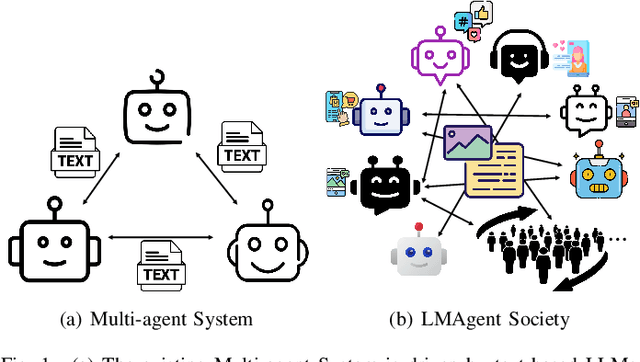
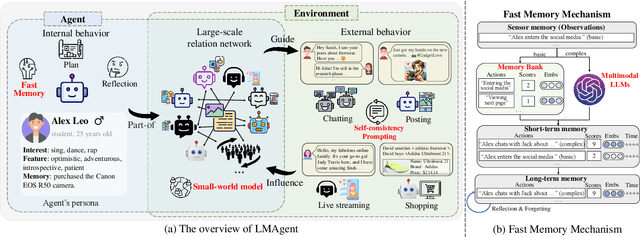
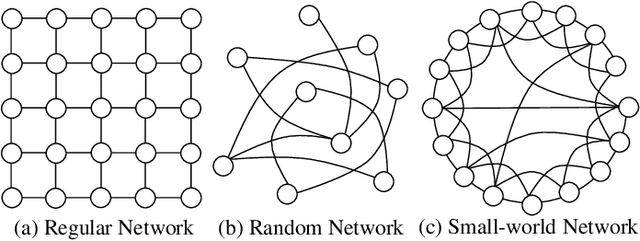
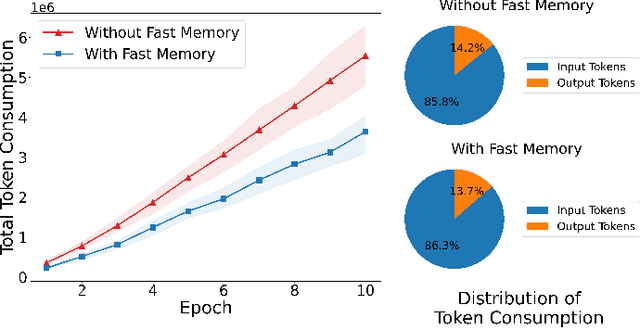
Abstract:The believable simulation of multi-user behavior is crucial for understanding complex social systems. Recently, large language models (LLMs)-based AI agents have made significant progress, enabling them to achieve human-like intelligence across various tasks. However, real human societies are often dynamic and complex, involving numerous individuals engaging in multimodal interactions. In this paper, taking e-commerce scenarios as an example, we present LMAgent, a very large-scale and multimodal agents society based on multimodal LLMs. In LMAgent, besides freely chatting with friends, the agents can autonomously browse, purchase, and review products, even perform live streaming e-commerce. To simulate this complex system, we introduce a self-consistency prompting mechanism to augment agents' multimodal capabilities, resulting in significantly improved decision-making performance over the existing multi-agent system. Moreover, we propose a fast memory mechanism combined with the small-world model to enhance system efficiency, which supports more than 10,000 agent simulations in a society. Experiments on agents' behavior show that these agents achieve comparable performance to humans in behavioral indicators. Furthermore, compared with the existing LLMs-based multi-agent system, more different and valuable phenomena are exhibited, such as herd behavior, which demonstrates the potential of LMAgent in credible large-scale social behavior simulations.
SigFormer: Sparse Signal-Guided Transformer for Multi-Modal Human Action Segmentation
Nov 29, 2023



Abstract:Multi-modal human action segmentation is a critical and challenging task with a wide range of applications. Nowadays, the majority of approaches concentrate on the fusion of dense signals (i.e., RGB, optical flow, and depth maps). However, the potential contributions of sparse IoT sensor signals, which can be crucial for achieving accurate recognition, have not been fully explored. To make up for this, we introduce a Sparse signalguided Transformer (SigFormer) to combine both dense and sparse signals. We employ mask attention to fuse localized features by constraining cross-attention within the regions where sparse signals are valid. However, since sparse signals are discrete, they lack sufficient information about the temporal action boundaries. Therefore, in SigFormer, we propose to emphasize the boundary information at two stages to alleviate this problem. In the first feature extraction stage, we introduce an intermediate bottleneck module to jointly learn both category and boundary features of each dense modality through the inner loss functions. After the fusion of dense modalities and sparse signals, we then devise a two-branch architecture that explicitly models the interrelationship between action category and temporal boundary. Experimental results demonstrate that SigFormer outperforms the state-of-the-art approaches on a multi-modal action segmentation dataset from real industrial environments, reaching an outstanding F1 score of 0.958. The codes and pre-trained models have been available at https://github.com/LIUQI-creat/SigFormer.
MSO: Multi-Feature Space Joint Optimization Network for RGB-Infrared Person Re-Identification
Oct 21, 2021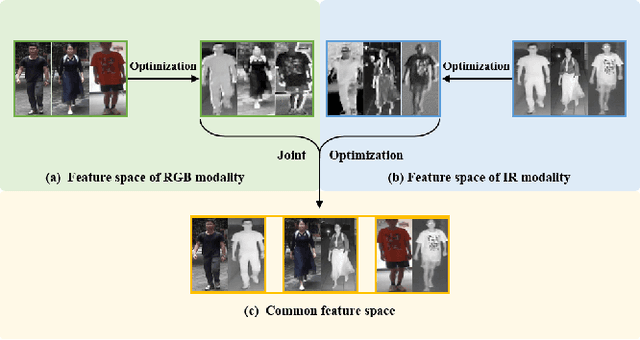
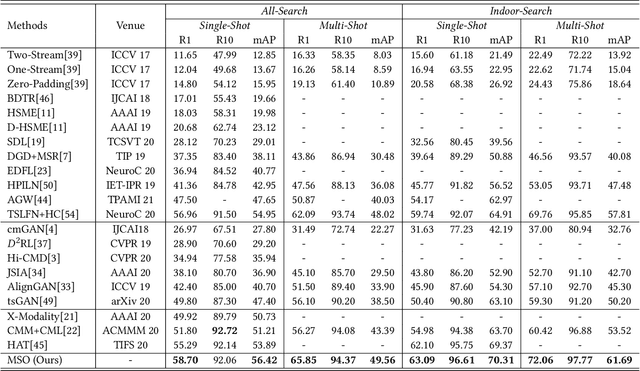
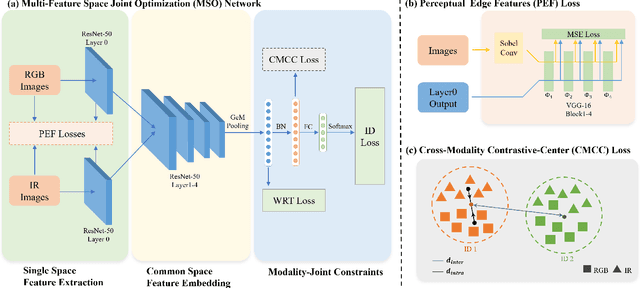
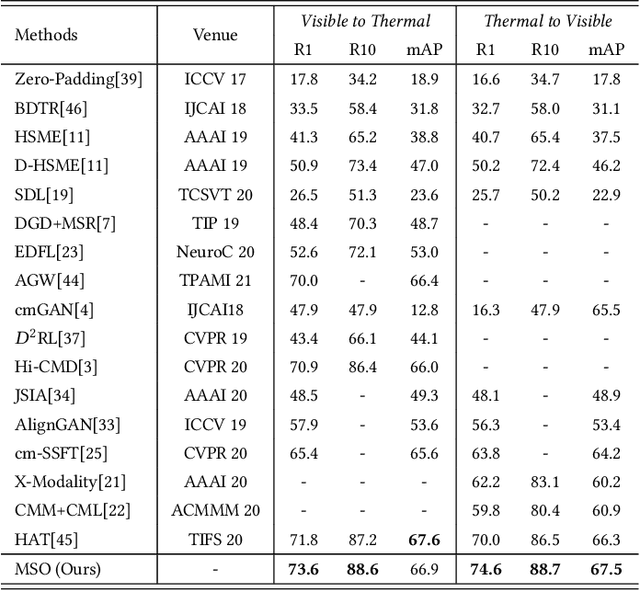
Abstract:The RGB-infrared cross-modality person re-identification (ReID) task aims to recognize the images of the same identity between the visible modality and the infrared modality. Existing methods mainly use a two-stream architecture to eliminate the discrepancy between the two modalities in the final common feature space, which ignore the single space of each modality in the shallow layers. To solve it, in this paper, we present a novel multi-feature space joint optimization (MSO) network, which can learn modality-sharable features in both the single-modality space and the common space. Firstly, based on the observation that edge information is modality-invariant, we propose an edge features enhancement module to enhance the modality-sharable features in each single-modality space. Specifically, we design a perceptual edge features (PEF) loss after the edge fusion strategy analysis. According to our knowledge, this is the first work that proposes explicit optimization in the single-modality feature space on cross-modality ReID task. Moreover, to increase the difference between cross-modality distance and class distance, we introduce a novel cross-modality contrastive-center (CMCC) loss into the modality-joint constraints in the common feature space. The PEF loss and CMCC loss jointly optimize the model in an end-to-end manner, which markedly improves the network's performance. Extensive experiments demonstrate that the proposed model significantly outperforms state-of-the-art methods on both the SYSU-MM01 and RegDB datasets.
Analyzing Periodicity and Saliency for Adult Video Detection
Jan 11, 2019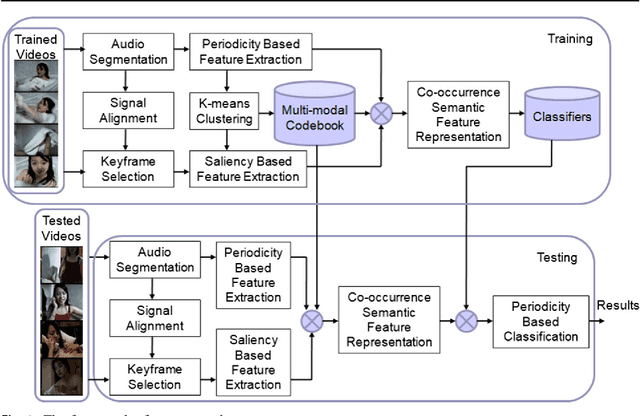

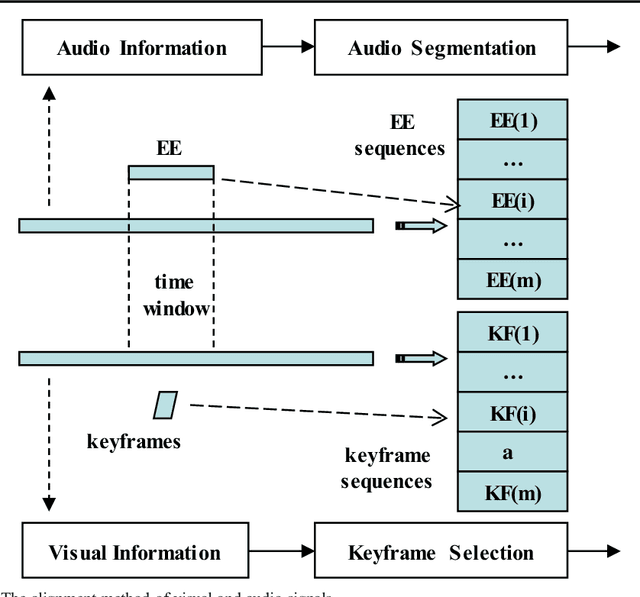
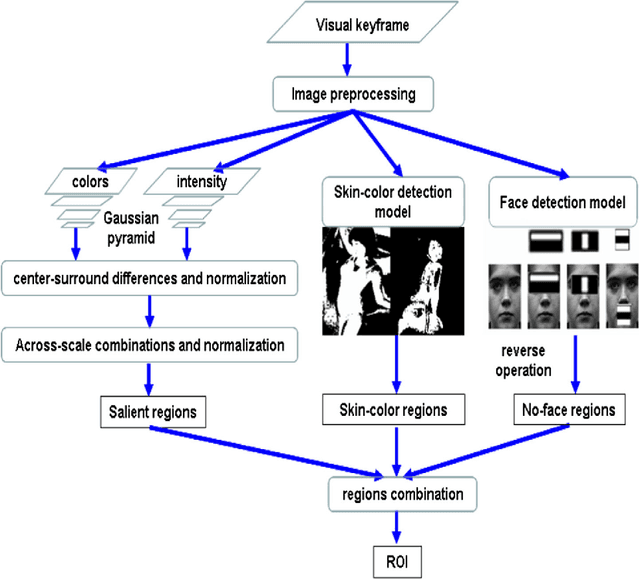
Abstract:Content-based adult video detection plays an important role in preventing pornography. However, existing methods usually rely on single modality and seldom focus on multi-modality semantics representation. Addressing at this problem, we put forward an approach of analyzing periodicity and saliency for adult video detection. At first, periodic patterns and salient regions are respective-ly analyzed in audio-frames and visual-frames. Next, the multi-modal co-occurrence semantics is described by combining audio periodicity with visual saliency. Moreover, the performance of our approach is evaluated step by step. Experimental results show that our approach obviously outper-forms some state-of-the-art methods.
 Add to Chrome
Add to Chrome Add to Firefox
Add to Firefox Add to Edge
Add to Edge